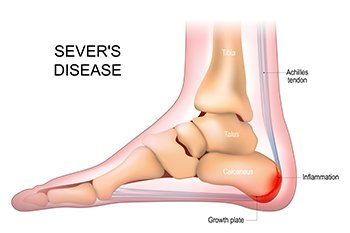Connect With Us
Blog

Sever’s disease, a common cause of heel pain in children, occurs when the growth plate at the back of the heel becomes irritated during development. It most often affects active children and adolescents who participate in running and jumping activities. Risk factors include rapid growth, tight calf muscles, flat feet, high arches, and sports that place repeated stress on the heel. Symptoms include heel pain during activity, limping, tenderness when the heel is squeezed, and stiffness after exercise. A podiatrist can evaluate the feet, recommend activity changes, provide heel support, and guide stretching routines that reduce discomfort. If your active child has heel pain, it is suggested that you schedule a visit with a podiatrist who can accurately diagnose and offer relief solutions for Sever’s disease.
Sever's disease often occurs in children and teens. If your child is experiencing foot or ankle pain, see one of our podiatrists from Whitestone Podiatry PC. Our doctors can treat your child’s foot and ankle needs.
Sever’s Disease
Sever’s disease is also known as calcaneal apophysitis, which is a medical condition that causes heel pain I none or both feet. The disease is known to affect children between the ages of 8 and 14.
Sever’s disease occurs when part of the child’s heel known as the growth plate (calcaneal epiphysis) is attached to the Achilles tendon. This area can suffer injury when the muscles and tendons of the growing foot do not keep pace with bone growth. Therefore, the constant pain which one experiences at the back of the heel will make the child unable to put any weight on the heel. The child is then forced to walk on their toes.
Symptoms
Acute pain – Pain associated with Sever’s disease is usually felt in the heel when the child engages in physical activity such as walking, jumping and or running.
Highly active – Children who are very active are among the most susceptible in experiencing Sever’s disease, because of the stress and tension placed on their feet.
If you have any questions, please feel free to contact our office located in Whitestone, NY . We offer the newest diagnostic and treatment technologies for all your foot care needs.

Flat feet occur when the arches sit lower than usual or collapse when standing, causing the entire sole to rest more fully on the ground. Some people are born with this structure, while others develop it over time due to tendon weakness, aging, injury, or extra stress on the feet. Low arches can lead to tired feet, aching ankles, or discomfort that travels into the knees or lower back because the body works harder to stay aligned. Many individuals also notice shoes wearing unevenly or feeling less supportive during long periods of standing or walking. Wearing supportive footwear, gentle strengthening, and early attention to soreness can improve comfort and prevent further strain. If you have persistent fatigue, instability, or pain related to low arches, it is suggested that you schedule an appointment with a podiatrist for a personalized evaluation.
Flatfoot is a condition many people suffer from. If you have flat feet, contact one of our podiatrists from Whitestone Podiatry PC. Our doctors will treat your foot and ankle needs.
What Are Flat Feet?
Flatfoot is a condition in which the arch of the foot is depressed and the sole of the foot is almost completely in contact with the ground. About 20-30% of the population generally has flat feet because their arches never formed during growth.
Conditions & Problems:
Having flat feet makes it difficult to run or walk because of the stress placed on the ankles.
Alignment – The general alignment of your legs can be disrupted, because the ankles move inward which can cause major discomfort.
Knees – If you have complications with your knees, flat feet can be a contributor to arthritis in that area.
Symptoms
- Pain around the heel or arch area
- Trouble standing on the tip toe
- Swelling around the inside of the ankle
- Flat look to one or both feet
- Having your shoes feel uneven when worn
Treatment
If you are experiencing pain and stress on the foot you may weaken the posterior tibial tendon, which runs around the inside of the ankle.
If you have any questions, please feel free to contact our office located in Whitestone, NY . We offer the newest diagnostic and treatment technologies for all your foot care needs.

Ankle sprains occur when the ligaments supporting the ankle stretch or tear, often caused by sudden twists, falls, uneven surfaces, or sports activities that involve running, jumping, or rapid changes in direction. They may look swollen, bruised, or slightly deformed, and in severe cases the ankle may appear unstable. Many individuals describe sharp pain at the moment of injury, followed by tenderness, stiffness, and difficulty bearing weight or walking normally. Lateral ankle sprains, affecting the ligaments on the outside of the ankle, account for nearly 70 percent of all ankle sprains, and repeated injuries can lead to chronic instability if not properly treated. A podiatrist can evaluate the ankle through physical examination and imaging, if needed, to rule out fractures. Treatment options include elevation, bracing, targeted exercises, and guidance on safe return to activity. Early intervention promotes faster recovery, reduces the risk of long-term complications, and supports proper joint function. If you experience persistent ankle pain or swelling after an injury, it is suggested that you make an appointment with a podiatrist.
Ankle sprains are common but need immediate attention. If you need your feet checked, contact one of our podiatrists from Whitestone Podiatry PC. Our doctors can provide the care you need to keep you pain-free and on your feet.
How Does an Ankle Sprain Occur?
Ankle sprains take place when the ligaments in your ankle are torn or stretched beyond their limits. There are multiple ways that the ankle can become injured, including twisting or rolling over onto your ankle, putting undue stress on it, or causing trauma to the ankle itself.
What Are the Symptoms?
- Mild to moderate bruising
- Limited mobility
- Swelling
- Discoloration of the skin (depending on severity)
Preventing a Sprain
- Wearing appropriate shoes for the occasion
- Stretching before exercises and sports
- Knowing your limits
Treatment of a Sprain
Treatment of a sprain depends on the severity. Many times, people are told to rest and remain off their feet completely, while others are given an air cast. If the sprain is very severe, surgery may be required.
If you have suffered an ankle sprain previously, you may want to consider additional support such as a brace and regular exercises to strengthen the ankle.
If you have any questions please feel free to contact our office located in Whitestone, NY . We offer the newest diagnostic tools and technology to treat your foot and ankle needs.

